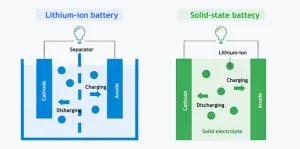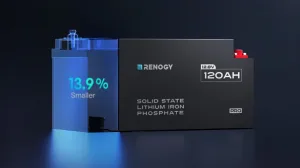World’s First Smart Semi-Solid State Battery Is Launched – Redefining Portable Energy Storage
The energy landscape is evolving at a breathtaking pace. From renewable power systems to electric vehicles and smart devices, the world is demanding faster, cleaner, and more efficient ways to store energy. And now, one of the most exciting breakthroughs in modern battery technology has arrived — the world’s first smart semi-solid state battery.
This revolutionary step forward is more than just an incremental improvement. It represents a total reimagining of how energy is stored, managed, and delivered. Built with advanced materials and intelligent design, the semi-solid state battery promises to change the way we think about portable energy storage, offering longer life, greater safety, and unprecedented smart functionality.

The Journey of Battery Innovation
For decades, battery technology has been central to human progress. From powering early telegraphs to driving today’s electric vehicles, each innovation in energy storage has opened new possibilities. Lead-acid batteries powered the first automobiles. Nickel-cadmium and nickel-metal hydride batteries made way for mobile devices. But it was the lithium-ion battery that truly revolutionized modern electronics and mobility.
Despite their success, lithium-ion batteries face several limitations. They rely on flammable liquid electrolytes that can overheat, leak, or even catch fire under certain conditions. They degrade over time, losing capacity after repeated charging. And while efficient, they struggle to balance performance, safety, and sustainability at scale.
Researchers have long sought a next-generation solution — one that could maintain energy density while eliminating the risks and inefficiencies of liquid electrolytes. This pursuit gave rise to solid-state battery technology, a system that replaces liquid electrolytes with solid materials. However, mass-producing solid-state batteries has proven extremely complex and costly.
The semi-solid state battery bridges that gap. It combines the stability and safety of solid electrolytes with the high conductivity of liquid systems, resulting in a hybrid energy solution that’s both powerful and practical.
What Exactly Is a Semi-Solid State Battery?
A semi-solid state battery features a unique electrolyte composition that is partly solid and partly liquid. The solid portion enhances mechanical stability and safety, while the liquid part maintains ion mobility and conductivity. This structure allows the battery to deliver the best of both worlds — higher safety than traditional lithium-ion designs and better manufacturability than fully solid-state batteries.

This hybrid design leads to several important benefits. First, it reduces the risk of short circuits and thermal runaway — a common issue with traditional batteries. Second, it allows for higher energy density, meaning more power can be stored in the same space. Third, it supports faster charging and improved thermal control, extending overall lifespan and reliability.
In simple terms, a semi-solid state battery is a smarter, stronger, and safer evolution of existing technology. It’s not just about holding more charge — it’s about holding it intelligently and efficiently, adapting to modern energy demands with unmatched precision.
Renogy — Pioneering the Future of Smart Energy
In the world of renewable power and off-grid solutions, Renogy has consistently been a name synonymous with innovation. Known for producing world-class solar panels, inverters, and LiFePO4 battery systems, Renogy has been instrumental in empowering consumers to harness clean, sustainable energy anywhere.
LiFePO4 (Lithium Iron Phosphate) batteries are already celebrated for their superior stability, safety, and long cycle life. They are less prone to overheating and can endure thousands of charge cycles without significant degradation. But Renogy’s integration of semi-solid state technology takes these advantages to the next level.
By combining advanced semi-solid chemistry with intelligent energy management, Renogy has effectively created a smart semi-solid state battery that thinks for itself. It monitors its own health, adjusts performance in real time, and communicates with external systems to ensure efficiency and safety at every stage.
This innovation positions Renogy as not just a hardware manufacturer but a leader in intelligent energy ecosystems — where data, materials, and design converge to create sustainable, user-centric power solutions.
What Is Solid State Battery Technology — and How Does It Differ?
Before diving deeper, it’s important to understand “What is solid state battery” technology and how it differs from this new semi-solid approach. A traditional solid-state battery replaces all liquid electrolytes with solid ones, such as ceramics, sulfides, or polymers. These materials offer improved safety and potentially higher energy density since they eliminate the flammable components found in lithium-ion designs.
However, solid-state batteries face challenges with ion conductivity and manufacturing complexity. Producing large-format cells is difficult, and ensuring stable contact between electrodes and electrolytes is even harder. That’s why, while promising, solid-state batteries remain in limited production and are mostly used in research or specialized applications.
The semi-solid state battery, on the other hand, takes a practical approach. By retaining some fluidity in the electrolyte, it maintains high ion transport efficiency while offering greater mechanical stability and reduced risk. It’s a compromise that delivers tangible benefits today — bridging the technological gap between current lithium-ion batteries and the fully solid systems of tomorrow.
Redefining Portable Energy Storage
One of the most exciting aspects of this innovation is its impact on portable energy storage. Whether it’s powering off-grid solar setups, outdoor adventures, emergency systems, or electric vehicles, semi-solid state batteries redefine convenience and reliability.
For portable applications, users often face three challenges: limited runtime, weight, and safety. The semi-solid state design addresses all three. Its high energy density allows for smaller, lighter systems with more capacity. Its enhanced safety makes it suitable for indoor or mobile use without fear of overheating or leakage. And its long cycle life ensures dependable performance even after years of heavy use.
Imagine carrying a power station that lasts twice as long, charges faster, and operates safely under extreme temperatures — from the deserts of Dubai to the snowy mountains of Canada. That’s the kind of advancement this technology brings to the table.

Beyond portability, semi-solid state batteries also support renewable integration. When paired with solar systems, they store clean energy more efficiently and release it steadily, balancing power needs for homes, RVs, and marine setups. The intelligence built into modern systems like Renogy’s ensures every watt of energy is used effectively, reducing waste and maximizing sustainability.
Smart Energy Management — Power That Thinks
What truly distinguishes the smart semi-solid state battery is its digital intelligence. Traditional batteries are passive — they charge, discharge, and require external devices to monitor their status. This new generation of smart batteries changes that model completely.
With embedded sensors and advanced battery management systems (BMS), these units continuously monitor key parameters like temperature, voltage, current, and capacity health. They can automatically balance cells, prevent overcharging, and adapt output based on demand. Some systems even connect to cloud platforms or mobile apps, allowing users to check real-time performance data and receive predictive maintenance alerts.
This isn’t just a battery — it’s an intelligent energy network. For example, in a solar setup, the smart BMS can communicate with inverters and charge controllers to optimize efficiency. It can predict when to draw or release power, extend battery life, and ensure the system performs at peak capacity.
In industrial applications, this intelligence minimizes downtime and maintenance costs, ensuring equipment operates smoothly and safely. In consumer devices, it guarantees that energy is delivered efficiently, reducing waste and enhancing convenience.
Environmental Benefits and Long-Term Sustainability
Beyond performance, the environmental impact of semi-solid state batteries is one of their most compelling advantages. The hybrid electrolyte design significantly reduces the need for volatile organic solvents and flammable materials, lowering both environmental and safety risks.
Because of their extended lifecycle, these batteries also contribute to reduced waste. A typical semi-solid battery can last thousands of charge cycles, meaning fewer replacements and less material consumption over time. Additionally, the use of safer and more stable materials simplifies recycling and disposal, aligning perfectly with global goals for sustainable manufacturing and circular energy systems.
Renogy’s approach focuses on creating eco-friendly energy ecosystems — integrating solar, battery, and smart control systems to reduce dependency on fossil fuels. The company’s expansion into semi-solid technology reflects a deeper commitment to a sustainable and intelligent energy future.
Real-World Applications and Market Potential
The impact of this new technology spans multiple sectors. In the automotive industry, semi-solid state batteries could help overcome one of the biggest hurdles for electric vehicles — range anxiety. Their higher energy density means vehicles can travel farther on a single charge, while faster charging and improved safety add to driver confidence.
In residential and commercial solar systems, they enable households and businesses to store renewable energy more efficiently. This creates stable microgrids and supports energy independence — a vital step toward decarbonization.
For portable power users, such as campers, digital nomads, and outdoor professionals, the new batteries redefine reliability. Devices powered by semi-solid systems can last longer, operate in extreme conditions, and require less maintenance.
Even in sectors like healthcare, telecommunications, and emergency services, where uninterrupted power is critical, these batteries provide dependable backup energy with real-time monitoring capabilities.
A Leap Toward the Future of Energy
The launch of the world’s first smart semi-solid state battery is more than a technical achievement — it’s a vision for the future of how energy will be managed. It bridges the gap between traditional batteries and the fully digital, intelligent systems that will define tomorrow’s world.
As technology continues to advance, we are likely to see further integration between smart batteries, renewable energy grids, and IoT devices. Imagine a future where every power system — from your car to your home — communicates seamlessly, adjusting energy flow based on demand, weather patterns, and user behavior. Semi-solid state technology is a crucial step in making that interconnected vision possible.
Conclusion — A Smarter, Safer, and More Sustainable Energy Era
The unveiling of the world’s first smart semi-solid state battery is a defining moment in energy history. It signifies the beginning of a new era where batteries are no longer passive storage units but active, intelligent participants in energy systems.
With the combined strengths of LiFePO4 battery chemistry, semi-solid design, and digital intelligence, this innovation delivers power that is safer, smarter, and longer-lasting. It sets new standards in portable energy storage, reshaping what consumers and industries can expect from modern energy technology.
Companies like Renogy are leading this transformation — proving that the future of power lies in smart chemistry, renewable integration, and sustainable design. As we step into this new era of intelligent energy, one thing is clear: the semi-solid state battery doesn’t just redefine portable power — it redefines possibility itself.

